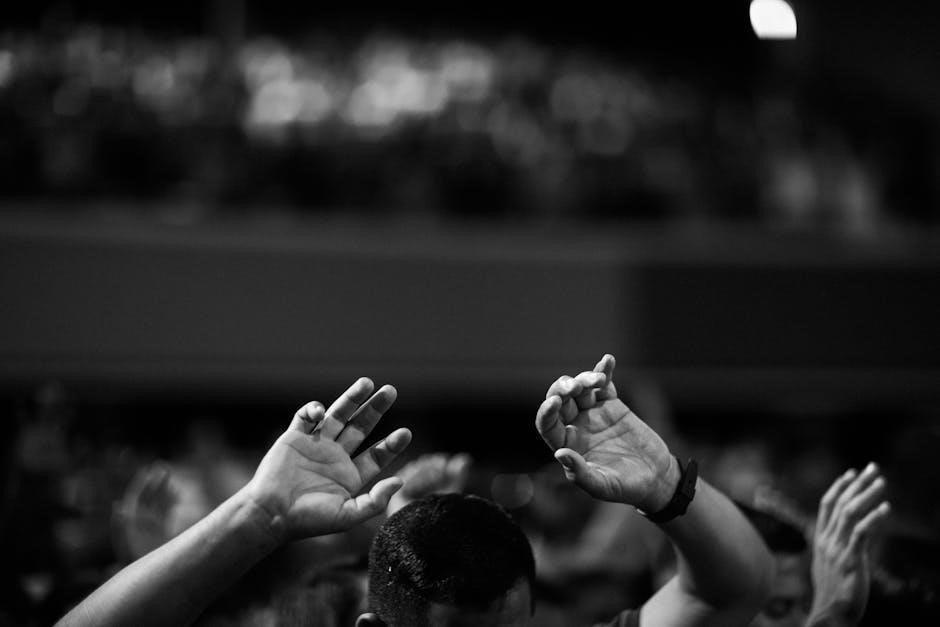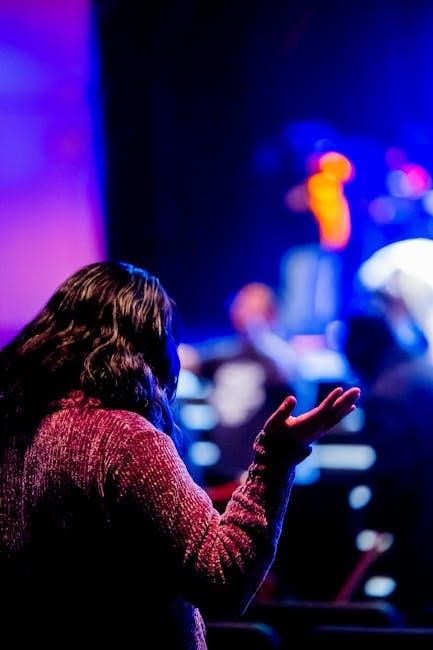
James W. Fowler’s theory of faith development outlines six stages, providing a framework to understand how faith evolves from infancy to maturity. His work, detailed in Stages of Faith (1981), offers insights into the structural progression of faith, influenced by Piaget and Kohlberg. Available in PDF resources, this theory applies broadly, encompassing both religious and secular worldviews, making it a valuable tool for understanding spiritual growth across diverse contexts.

Pre-Stage: Infancy and Undifferentiated Faith
This pre-stage lays the groundwork for faith, focusing on the development of trust, courage, hope, and love. It addresses the seeds of faith amidst challenges like abandonment and inconsistency.
The pre-stage of infancy and undifferentiated faith spans from birth to approximately two years of age. During this period, infants begin to develop basic trust through interactions with caregivers, laying the foundation for future faith. Characteristics include a sense of mutuality and the initial seeds of courage, hope, and love. This stage is marked by a lack of differentiation between self and others, with faith expressed through primal trust and sensory experiences. It is a critical period where the environment either nurtures or undermines the development of healthy faith.
Role in Faith Development
The pre-stage of infancy and undifferentiated faith plays a foundational role in shaping future faith development. It establishes basic trust, a sense of mutuality, and the initial seeds of courage, hope, and love. These elements form the bedrock upon which all subsequent stages of faith are built. Positive experiences during this phase foster resilience and openness to growth, while negative experiences may lead to mistrust or fear. This stage is crucial as it sets the trajectory for how individuals will perceive and engage with faith throughout their lives, influencing their capacity for meaningful spiritual connection and understanding.

Stage 1: Intuitive-Projective Faith
Stage 1: Intuitive-Projective Faith occurs in early childhood (ages 2-7). It involves fantasy, imagination, and imitative behaviors, deeply influenced by stories and examples from the environment.
Stage 1: Intuitive-Projective Faith typically occurs during early childhood, spanning ages 2 to 7. At this stage, children begin to use language and symbols to express their thoughts. Their understanding of faith is heavily influenced by imagination, fantasy, and storytelling. They often blend reality and fantasy, with a strong emphasis on trust and courage. This phase is foundational, as it lays the groundwork for later faith development by fostering a sense of wonder and basic trust in the world. It is a period of imitation and emotional connection, shaped by their immediate environment and caregivers.
During Stage 1: Intuitive-Projective Faith, children often engage in imaginative play and storytelling, blending fantasy with reality. For example, they may believe in magical figures like Santa Claus or interpret prayer as a means to influence events. Their faith is heavily shaped by their immediate environment, including family rituals, stories, and emotional connections with caregivers. This stage is deeply influenced by sensory experiences and the imitation of adult behaviors, fostering a sense of trust and wonder. These early experiences lay the groundwork for future spiritual development, emphasizing the importance of nurturing environments in shaping faith.
Stage 2: Mythic-Literal Faith
Children aged 7-12 begin interpreting stories as factual, seeking moral lessons. They literalize religious narratives, developing a clear sense of right and wrong based on these stories.
Stage 3, Synthetic-Conventional Faith, typically occurs during adolescence, around ages 12 to 18. At this stage, individuals integrate their beliefs into a cohesive system, seeking consistency and harmony. They often adopt the perspectives of their community or authority figures, valuing tradition and group expectations. Faith becomes a way to maintain identity and belonging, blending personal beliefs with external teachings. This stage is marked by a desire for consensus and a reliance on established moral guidelines, reflecting a more structured and conventional approach to faith.
During Synthetic-Conventional Faith, individuals often participate in organized religious practices, such as attending church services or youth groups, reflecting their adoption of community values. They may internalize moral teachings from authority figures, such as parents or religious leaders, and align their beliefs with societal norms. For example, a teenager might actively engage in rituals or traditions, viewing faith as a source of belonging and moral guidance. Influences include family, cultural traditions, and institutional teachings, shaping their understanding of faith as a unified, structured system that provides meaning and direction in life.
Stage 3: Synthetic-Conventional Faith
Emerging in early adolescence (12-18 years), this stage involves forming a coherent belief system, integrating teachings from authority figures, and viewing faith as a source of identity and belonging, providing a sense of meaning and moral guidance.
Stage 3, Synthetic-Conventional Faith, typically occurs during early adolescence, roughly between ages 12 and 18. At this stage, individuals begin to synthesize their beliefs into a coherent system, heavily influenced by external authorities such as family, community, and religious institutions. Faith becomes a source of identity and belonging, providing a sense of moral and ethical guidance. This stage is marked by conformity to accepted norms and traditions, with a focus on maintaining social harmony and adhering to established doctrines. The individual’s understanding of faith is still largely defined by external sources rather than personal reflection or critical examination.
During the Synthetic-Conventional stage, individuals often participate in organized religious practices, such as attending church services or youth groups, where they internalize teachings and values. They may also be influenced by family traditions, community norms, and authoritative figures like pastors or teachers. For example, a teenager might adopt a set of beliefs because they align with their family’s practices or societal expectations. This stage is also marked by a reliance on external sources for moral guidance, such as religious texts or community leaders, which shape their understanding of faith and its role in daily life.
Stage 4: Individuative-Reflective Faith
During this stage, individuals question inherited beliefs, seeking personal identity and a more reflective faith, often occurring in late adolescence to early adulthood.
The age range for Stage 4 typically spans late adolescence to early adulthood, roughly between 18 and 30 years old. During this phase, individuals begin to question and reflect on their inherited beliefs, seeking a more personalized and authentic faith. They explore their own identity and values, often experiencing a shift from conventional to more reflective faith. This stage is characterized by critical thinking, self-examination, and the integration of faith into a coherent worldview, marking a significant transition toward maturity and independence in spiritual understanding.
During Stage 4, individuals often explore diverse religious texts, philosophical ideas, and existential questions, seeking a personalized faith. They may engage in introspective practices like journaling or meditation. Influences include mentors, significant life events, and exposure to different cultures or belief systems. This stage is marked by a shift from external authority to internal reflection, with individuals integrating their experiences into a coherent worldview. The synthesis of faith and personal identity becomes a central theme, often leading to a deeper, more authentic spiritual life shaped by both tradition and individual insight.
Stage 5: Conjunctive Faith
Conjunctive Faith involves reconciling contradictions and embracing paradoxes, often emerging in mid-life. It integrates diverse perspectives, fostering humility and empathy, while valuing interconnectedness and deeper spiritual unity.
Stage 5: Conjunctive Faith typically emerges in mid-life, often during the 40s or 50s. It is characterized by the ability to reconcile contradictions and paradoxes, fostering a deeper sense of humility and empathy. Individuals in this stage seek to integrate diverse perspectives, embracing the interconnectedness of all things. This phase often involves a reunification of earlier faith elements with new insights, leading to a more unified and mysterious understanding of faith. The focus shifts to valuing both the particular and the universal, creating a more inclusive and compassionate worldview.
In Stage 5: Conjunctive Faith, individuals often engage in interfaith dialogue or social justice efforts, reflecting their ability to reconcile diverse perspectives. Influences may include exposure to various spiritual traditions, philosophical texts, or personal experiences of loss and renewal. This stage is marked by a deepening sense of interconnectedness, often inspired by mentors or role models who embody wisdom and compassion. The integration of past faith experiences with new insights fosters a more inclusive and empathetic worldview, as individuals seek to address global challenges and promote unity amidst diversity.

Stage 6: Universalizing Faith
Stage 6 represents the pinnacle of faith development, characterized by a universal and global perspective. It transcends specific beliefs, emphasizing compassion and unity across humanity.
Age Range and Characteristics
Stage 6: Universalizing Faith typically occurs in late adulthood, though it is rare. It is characterized by a global perspective, transcending specific beliefs to emphasize compassion and justice. Individuals in this stage see all humanity as interconnected, addressing universal issues. Their faith becomes a unifying force, focusing on the well-being of all. This stage is marked by a deep understanding of diverse beliefs and a commitment to ethical living. It represents the pinnacle of faith development, where one’s beliefs embrace the entirety of human experience.
Examples and Influences
Each stage of Fowler’s faith development is illustrated by unique examples and influenced by various factors. For instance, Stage 1: Intuitive-Projective Faith (ages 2-7) is marked by imaginative play and imitative behaviors, influenced by family, culture, and storytelling. Stage 2: Mythic-Literal Faith (ages 7-12) involves literal interpretations of religious narratives, shaped by community and moral teachings. Stage 3: Synthetic-Conventional Faith (adolescence to young adulthood) is characterized by forming a personal identity, influenced by social and religious norms. Stage 4: Individuative-Reflective Faith (adulthood) often involves personal reflection and existential questioning, influenced by life experiences and philosophical inquiry. Stage 5: Conjunctive Faith (later adulthood) embraces paradox and diversity, influenced by exposure to other faiths and deeper life experiences. Stage 6: Universalizing Faith, rare and occurring in late adulthood, is characterized by a global perspective and commitment to universal justice and compassion, influenced by profound life experiences and a deep understanding of humanity’s interconnectedness.

Practical Applications of Fowler’s Theory
James Fowler’s stages of faith development offer practical applications in religious education, counseling, and community building. Understanding these stages helps educators tailor programs to meet individuals where they are in their faith journey. Counselors can use this framework to address spiritual struggles and foster growth. Churches and organizations can create inclusive environments that support diverse faith expressions. Fowler’s theory also aids in interfaith dialogue by recognizing common patterns in spiritual development. Additionally, PDF resources and summaries of his work provide accessible tools for educators, leaders, and individuals seeking to apply his insights in real-world settings to promote spiritual growth and understanding.
PDF Resources and Further Reading
Several PDF resources and guides are available for deeper exploration of James Fowler’s stages of faith. His seminal book, Stages of Faith: The Psychology of Human Development and the Quest for Meaning (1981), can be accessed in digital formats. Additionally, academic summaries, lecture notes, and articles provide concise overviews of his theory. Websites like Internet Archive and academic platforms offer downloadable PDFs, making his work widely accessible. These resources are invaluable for educators, researchers, and individuals seeking to understand and apply Fowler’s framework in various contexts, ensuring continued engagement with his transformative ideas.